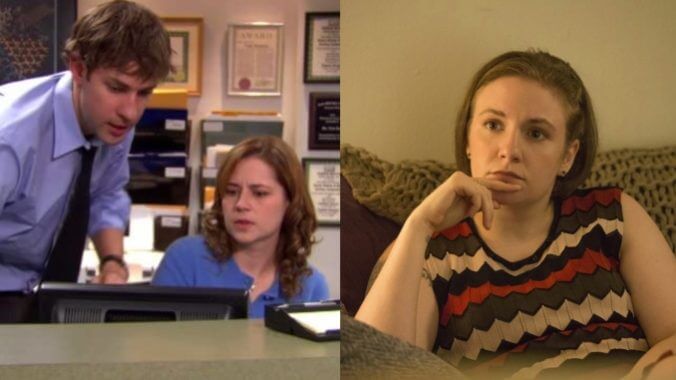How the “Will They, Won’t They?” Couple Got Dumped in April 2012

In the autumn of 2012, the final season of The Office premiered on NBC. The Office had ushered in a new style of comedy that balanced the cruel absurdity of cringe (which it shared with its British source material,) and its peculiarly American optimism (which…it did not borrow from Gervais’ version.) But Season 9 was the overdue final chapter to this story. Only a few months earlier a very different comedy had premiered on HBO and garnered critical attention. Think of Girls as a millennial version of Sex and the City, taking place in a slightly quirkier, if equally accommodating, New York City. The show was Lena Dunham’s vehicle to the public consciousness. Most of the dynamics were understood to be at least semi-autobiographical; her character, Hannah, was an aspiring writer, tweeting furiously while also stumbling into a series of outrageous romantic rendezvous.
Sitting side by side, these programs highlight the effortless slide from a traditional sitcom structure into a blurred, harsher form of comedy. With that, came a new way of watching TV coupledom. In 2012, the “will they, won’t they?” model of romance was, fittingly, dumped.
Before this breakup, the “will they, won’t they?” mode was a reliable way to ensnare an audience’s attention. Over the years a steady stream of couples were showcased circling one another, dramatically falling in and out of love. Seasons would pass and with it countless opportunities for these fictional pairs to confirm their love for one another, yet they rarely revealed their feelings until the end of a show. Gradually, Sam and Diane, Carrie and Big, Ross and Rachel, and others are no longer underscored with an excited “will they?” but with a resigned “when will they?” Couples that were molded with the tantalizing prospect of romance in mind were inevitably sacrificed at its altar, any individuality leaking away until the looming question grew bigger and bigger, obscuring the subject of the inquiry.
Most of the couples that are commonly associated with this trend were from TV of the 80s and 90s. This is not incidental; they were, unwittingly, acting as the idealistic antidote to an increasingly isolated American public. In a national landscape decimated by Reagan’s ideology of individualism, the vibrant, unreal world of the sitcom was quasi-utopian. The desire to watch people discover an immediate, inexplicable connection was ripe, ready to be harvested by any opportunistic showrunner. In this sense the sitcom was perfectly poised to fulfill this request.
An American invention that is easier to identify than define, the sitcom often reflects the demographic watching it. It is a smoothed-out, silly time capsule, capturing a sense of period-specific normalcy. Above all, the sitcom is defined by a respectful distance; the characters are there to be fondly observed. As viewers we are rarely asked to delve into their intricacies or inconsistencies, preferring to watch them wander into farcical scenarios. This distinction is made obvious in certain formats; the cackling laughter of the live studio audience swells to build a pocket of space between actor and audience and the multi-camera setup mimics the physical distance between the stage and the seats in live theatre. Perhaps the mockumentary is best at swiftly constructing a relational dissociation between subject and viewership.
Maybe this is why the sitcom was the container most suited to collect the reliable influx of on again-off again couples rolling on to screens each year. It works to balance the identifiable quirks of everyday life and the distance necessary to insulate the audience in an escapist fantasy. These friends are watching TV and drinking coffee—just like you! But they are also unreasonably beautiful and granted unlimited free time. These women complain about the crowded hubbub of New York—me too! And yet travelling across this city is only a matter of will for them. An easy balance of relatable and unattainable elevates the “will they, won’t they?” couple; one part believable chemistry and one part unrealistic circumstances that continue to thwart the potential lovers’ happiness. The real and the unreal are stirred together and offered up as a sweet, if empty, dish.
-

-

-

-

-

-

-

-

-

-

-

-

-

-

-

-

-

-

-

-

-

-

-

-

-

-

-

-

-

-

-

-

-

-

-

-

-

-

-

-








































